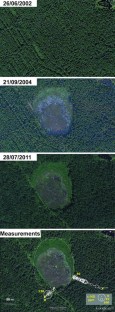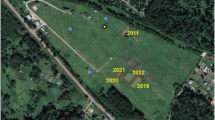Abstract
In the Russian part of the European craton, several thousands of subcircular structures ranging in size from a hundred meters to several kilometers in diameter have been identified throughout the region extending from Moscow to Kazakhstan. Generally, these structures correspond to minor morphological depressions. In cultivated areas, the periphery of these structures is often outlined by a ring of soil bleaching associated with growth anomalies of vegetation. The cores of the structures commonly correspond to marshes, sometimes with lakes. Subsoil gas composition of these structures was studied. For this purpose, portable gas detectors were used, and the results obtained were confirmed by gas chromatography analysis. Inside and around these structures, the concentration of molecular hydrogen in soil was much greater inside than outside, up to 1.25% at 1.2 m in soils. The hydrogen is associated with a small quantity of methane. We estimated a daily hydrogen flow seeping out at the surface is between 21,000 and 27,000 m3 in one of these structures.









Similar content being viewed by others
Notes
Updates are published regularly on http://hydrogen-future.com/en/.
References
Abrajano, T. A., Sturchio, N., Bohlke, J. K., Lyon, G., Poreda, R., & Stevens, C. (1988). Methane-hydrogen gas seeps, Zambales Ophiolite, Philippines: Deep or shallow origin? Chemical Geology, 71, 211–222.
Abrajano, T. A., Sturchio, N. C., Kennedy, B. M., Lyon, G. L., Muehlenbachs, K., & Bohlke, J. K. (1990). Geochemistry of reduced gas related to serpentinization of the Zambales ophiolite, Philippines. Applied Geochemistry, 5, 625–630.
Angino, E. E., Coveney, R. M. J., Goebel, E. D., Zeller, E. J., & Dreschhoff, G. A. M. (1984). Hydrogen and nitrogen—origin, distribution, and abundance, a followup. Oil & Gas Journal, 82, 142–146.
Apps, J.A., Van De Kamp, P.C. (1993). Energy gases of abiogenic origin in the Earth’s crust. Future Energy Gases. United States Geological Survey Professional Paper, pp. 81–130.
Birina, L.M. (Ed.). (1962). Map of pre-quaternary formations: N-37-III. Scale 1:200000. Geologic administration of Central regions (in Russian).
Charlou, J.-L. (2002). Geochemistry of high H2 and CH4 vent fluids issuing from ultramafic rocks at the Rainbow hydrothermal field (36°14′N, MAR). Chemical Geology, 191, 345–359.
Charlou, J.-L., Fouquet, Y., Bougault, H., Donval, J. P., Etoubleau, J., Jean-Baptiste, P., et al. (1998). Intense CH4 plumes generated by serpentinization of ultramafic rocks at the intersection of the 15°20′N fracture zone and the Mid-Atlantic Ridge. Geochimica et Cosmochimica Acta, 62, 2323–2333.
Coveney, R. M. J., Goebel, E. D., Zeller, E. J., Dreschhoff, G. A. M., & Angino, E. E. (1987). Serpentinization and origin of hydrogen gas in Kansas. AAPG Bulletin, 71, 39–48.
Cussler, E. L. (2009). Diffusion. Mass transfer in fluid systems. Cambridge University Press. Deville E., Guerlais S.-H. 2009. Cyclic activity of mud volcanoes: Evidences from Trinidad (SE Caribbean). Marine and Petroleum Geology, Special issue on mud volcanoes, 26, 1681–1691.
Deville, E., & Guerlais, S.-H. (2009). Cyclic activity of mud volcanoes: Evidences from Trinidad (SE Caribbean). Marine and Petroleum Geology, 26(9), 1681–1691.
Firstov, P. P., & Shirokov, V. A. (2005). Dynamics of molecular hydrogen and its relation to deformational processes at the Petropavlovsk–Kamchatskii geodynamic test site: Evidence from observations in 1999–2003. Geochemistry International, 43, 1056–1064.
Freund, F., Dickinson, J. T., & Cash, M. (2002). Hydrogen in rocks: an energy source for deep microbial communities. Astrobiology, 2(1), 83–92.
Iosifova, Yu. I., Gorbatkina, T. E., & Fadeeva, L. I. (1998). Geologic map of pre-quaternary sediments of Voronezh region. Scale 1:500 000. Ed. Gavryushova, E. A., Dashevskiy, V. V. Ministry of Natural Resources of Russian Federation (In Russian).
Gusev, A. (1997). Gas-geochemical effects of modern geodynamic activity of platform structures (on example of South-East of Belarus). Schmidt Institute of Physics of the Earth of Russian Academy of Sciences. Dissertation (in Russian).
Hosgörmez, H., Etiope, G., & Yalçin, M. N. (2008). New evidence for a mixed inorganic and organic origin of the Olympic Chimaera fire (Turkey): A large onshore seepage of abiogenic gas. Geofluids, 4, 263–273.
Ikorsky, S. V., Gigashvili, G. M., Lanyov, V. S., Narkotiev, V. D., & Petersilye, I. A. (1999). The investigation of gases during the Kola Superdeep Borehole Drilling (to 11.6 km Depth), in: Whiticar, M. J., Faber, E. (Eds.), Geologisches Jahrbuch Reihe, D. E. Schweizerbart Science Publishers, Hannover, pp. 145–152.
Isaev, E. I., Skorodumova, N. V., Ahuja, R., Vekilov, Y. K., & Johansson, B. (2007). Dynamical stability of Fe–H in the Earth’s mantle and core regions. PNAS of the USA, 104, 9168–9171.
Jones, V.T., & Pirkle, R.J. (1981). Helium and hydrogen soil gas anomalies associated with deep or active faults, in: 181st ACS National Meeting. Atlanta.
Kotelnikova, S. (2002). Microbial production and oxidation of methane in deep subsurface. Earth-Science Reviews, 58, 367–395.
Larin, V.N. (1993). Hydridic Earth: the New Geology of Our Primordially Hydrogen-rich Planet. Ed. C. W. Hunt. Polar publishing, Alberta.
Larin, N.V., Larin, V.N., & Gorbatikov A.V. (2010). Circular structures, caused by the deep seeping of hydrogen. Degassing of the Earth: Geotectonics, geodynamics, Deep Fluids, oil and gas; hydrocarbons and life. Russian Conference with International Participation Dedicated to the 100th Anniversary of Academician P.N. Kropotkin, p. 282 (in Russian).
Lin, L.-H., Hall, J., Lippmann-Pipke, J., Ward, J. A., Lollar, B. S., DeFlaun, M., et al. (2005). Radiolytic H2 in continental crust: Nuclear power for deep subsurface microbial communities. Geochemistry, Geophysics, Geosystems, 6(7), 1–13.
McCarthy, H., & McGuire, E. (1998). Soil gas studies along the Carlin trend, Eureka and Elko counties, Nevada. In: Tosdal, R.M. (Ed.), Contributions to the Gold Metallogeny of Northern Nevada. Open-File Report 98-338 1998. U.S. Dept. of the Interior, U.S. Geological Survey, pp. 243–250.
Mukhin, Y. (1970). Main results of the deep hydrogeological studies in Central Russia sedimentation basin in connection with estimation of the prospects for oil and gas. Proceedings of VNIIGaz, (33/41), pp. 157–295 (in Russian).
Neal, C., & Stanger, G. (1983). Hydrogen generation from mantle source rocks in Oman. Earth and Planetary Science Letters, 66, 315–320.
Newell, K. D., Doveton, J. H., Merriam, D. F., Lollar, B. S., Waggoner, W. M., & Magnuson, L. M. (2007). H2-rich and hydrocarbon gas recovered in a deep precambrian well in Northeastern Kansas. Natural Resources Research, 16, 277–292.
Proskurowski, G., Lilley, M. D., Kelley, D. S., & Olson, E. J. (2006). Low temperature volatile production at the Lost City Hydrothermal Field, evidence from a hydrogen stable isotope geothermometer. Chemical Geology, 229, 331–343.
Rogozhin, E. A., Gorbatikov, A. V., Larin, N. V., & Stepanova, M. Y. (2010). Deep structure of the Moscow Aulacogene in the western part of Moscow. Izvestiya, Atmospheric and Ocean. Physics, 46, 973–981.
Sano, Y., Urabe, A., Wakita, H., & Wushiki, H. (1993). Origin of hydrogen–nitrogen gas seeps, Oman. Applied Geochemistry, 8, 1–8.
Sato, M., Sutton, A. J., McGee, K. A., & Russell-Robinson, S. (1986). Monitoring of hydrogen along the San Andreas and Calaveras Faults in central California in 1980–1984. Journal of Geophysical Research, 91, 12315–12326.
Semlitsch, R. D. (2000). Size does matter: The value of small isolated wetlands. National Wetlands Newsletter, 22, 5–6.
Shcherbakov, A. V., & Kozlova, N. D. (1986). Occurrence of hydrogen in subsurface fluids and the relationship of anomalous concentrations to deep faults in the USSR. Geotectonics, 20, 120–128.
Sherwood Lollar, B., Lacrampe-Couloume, G., Slater, G. F., Ward, J. A., Moser, D. P., Gihring, T. M., et al. (2006). Unravelling abiogenic and biogenic sources of methane in the Earth’s deep subsurface. Chemical Geology, 226, 328–339.
Shestopalov, V. M., & Makarenko, A. N. (2013). On several results of research, developing the idea of V.I. Vernadskiy about “gas breathing” of the Earth. Geological Journal, 3, 7–25. (in Russian).
Shik, S.M. (Ed.), (2000). Map of pre-quaternary formations: M-37, (38) (Voronezh). Scale 1:1000000. FGUP “VSEGEI” (in Russian).
Shishov, S. I. (2010). Geography and soil geochemistry characteristics of delineated depressions in the Ryazan region. Bulletin of the Esenin Ryazan State University, 28(3), 116–129. (in Russian).
Smith, N.J.P., Shepherd, T.J., Styles, M.T., & Williams, G.M., (2005). Hydrogen exploration: a review of global hydrogen accumulations and implications for prospective areas in NW Europe, in: Petroleum Geology: North-West Europe and Global Perspectives—Proceedings of the 6th Petroleum Geology Conference. Geological Society, London, pp. 349–358.
Sukhanova, N. I., Trofimov, S. Y., Polyanskaya, L. M., Larin, N. V., & Larin, V. N. (2013). Changes in the humus status and the structure of the microbial biomass in hydrogen exhalation places. Eurasian Soil Science, 46, 135–144.
Syvorotkin, V. L. (2010). Hydrogen degassing of the earth: Natural disasters and the biosphere. Man and the Geosphere (pp. 307–347). New York: Nova Science Publishers.
Takai, K., Gamo, T., Tsunogai, U., Nakayama, N., Hirayama, H., Nealson, K.H., & Horikoshi, K. (2004). Geochemical and microbiological evidence for a hydrogen-based, hyperthermophilic subsurface lithoautotrophic microbial ecosystem (HyperSLiME) beneath an active deep-sea hydrothermal field. Extremophiles, 8, 269–82.
Toulhoat, H., Beaumont, V., Zgonnik, V., Larin, N. V., & Larin, V. N. (2012). Chemical differentiation of planets: a core issue. Submitted for publication. Available at: http://arxiv.org/abs/1208.2909.
Urdukhanov, R. I., Nikolaev, I. N., Voytov, G. I., Daniyalov, M. G., Prutskaya, L. D., Parshikova, N. G., et al. (2002). Instability of the hydrogen field in atmosphere of soils and subsoils in response to the earthquake in Dagestan in 1998–2000. Proceedings of the Academy of Science, Section Geophysics, 385(6), 818–822. (in Russian).
Vacquand, C., (2011). Genèse et mobilité de l’hydrogène dans les roches sédimentaires: source d’énergie naturelle ou vecteur énergétique stockable? PhD dissertation. IFP Energies Nouvelles and Institut de Physique du Globe de Paris. Available at: http://www.ipgp.fr/docs/publications/theses/20110318-vacquand.pdf.
Wakita, H., Nakamura, Y., Kita, I., Fujii, N., & Notsu, K. (1980). Hydrogen release: New indicator of fault activity. Science (New York, N.Y.), 210, 188–190.
Ware, R. H., Roecken, C., & Wyss, M. (1985). The detection and interpretation of hydrogen in fault gases. Pure and Applied Geophysics PAGEOPH, 122, 392–402.
Welhan, J. A., & Craig, H. (1979). Methane and hydrogen in East Pacific rise hydrothermal fluids. Geophysical Research Letters, 6, 829–831.
Zgonnik, V., Beaumont, V., Deville, E., Larin, N., Pillot, D., & Farrell, K. Evidence for natural molecular hydrogen seepage associated with surficial, rounded depressions. The Atlantic Coastal Plain Province of the USA (Under review).
Acknowledgement
We thank Hervé Toulhoat and Armand Lattes for their support for this research topic, ZAO “NTK” for their assistance with funding for this research, Pavel Vodnev, Aleksandr Sysolin, Olga Veretennikova, Irina Katsura, Vladimir Larin (Jr.) for their assistance with the fieldwork, and the anonymous reviewers for their comments and critics.
Author information
Authors and Affiliations
Corresponding author
Electronic supplementary material
Below is the link to the electronic supplementary material.
Rights and permissions
About this article
Cite this article
Larin, N., Zgonnik, V., Rodina, S. et al. Natural Molecular Hydrogen Seepage Associated with Surficial, Rounded Depressions on the European Craton in Russia. Nat Resour Res 24, 369–383 (2015). https://doi.org/10.1007/s11053-014-9257-5
Received:
Accepted:
Published:
Issue Date:
DOI: https://doi.org/10.1007/s11053-014-9257-5




